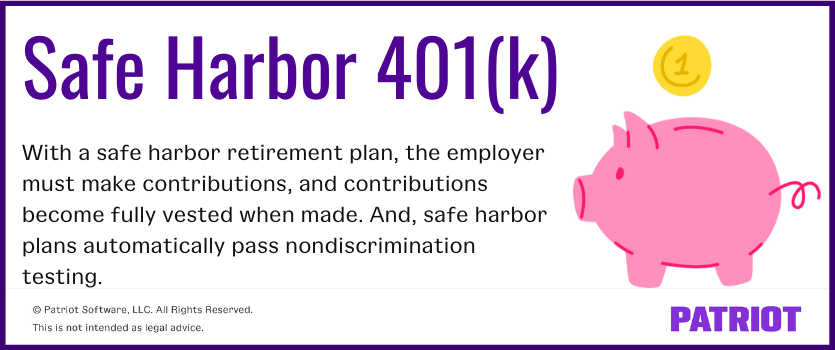In the United States, the most common type of retirement plan is the trusty 401(k). With over 60 million active participants and an estimated $7.3 trillion in assets, businesses of all sizes offer this type of plan to help their employees save for the retirement they deserve.
However, not all 401(k)s are the same. While offering any retirement plan can be a huge benefit, a “safe harbor” 401(k) plan can be a particular win-win. Safe harbor plans can maximize a company’s tax savings and retain employees, all while simplifying responsibilities for the employer.
So what exactly is a safe harbor 401(k), and what makes it so special? Read on for a Q&A on everything you need to know about this unique type of plan available to you now.
What is a safe harbor 401(k)?
Like a traditional 401(k), a safe harbor plan gives employees access to a tax-advantaged savings and investment account. Generally, contributions to this account are automatically withdrawn from an employee’s paycheck and invested into funds of the employee’s choosing.
However, the key difference between a traditional and a safe harbor 401(k) is in the employer contribution: With a safe harbor retirement plan, the employer must make contributions, and contributions become fully vested when made. Safe harbor contributions can either be limited to employees who make deferrals or offered to all eligible employees.

How do small businesses benefit from safe harbor plans?
When 401(k) plans were first introduced, a central goal of the program was to ensure as many employees as possible participated, and that businesses didn’t disproportionately favor their highly-compensated employees when making employer contributions. As a result, traditional 401(k) plans are subject to what’s called “nondiscrimination testing,” a form of compliance auditing that ensures the average contributions of highly paid employees don’t exceed those of everyone else by more than 2%.
If the thought of this added paperwork turns you off, then a safe harbor plan may be for you.
Unlike traditional 401(k) plans, safe harbor plans automatically pass a number of required tests that keep the plan tax-qualified and avoid other penalties and costs. For this reason, safe harbor plans can be a great choice for small businesses that could have trouble passing nondiscrimination testing (e.g., family-owned businesses with highly compensated employees).
Not to mention, safe harbor plans are available to everyone at a company, including business owners who work for their company. These employers can contribute the maximum annual deferral amount to their own 401(k) plan, which is $23,000 for 2024, plus any catch-up contributions. Further, come tax time, employers can minimize their business’s expenses by deducting applicable employee and employer matching contributions from the company. Because many owners pay themselves out of their company’s profits, these savings can directly improve their bottom line.
How do employer contributions work in a safe harbor plan?
There are three “categories” of employer contributions that a business can choose to commit to when designing its safe harbor plan. These include:
- Basic match: The employer matches 100% on the first 3% of deferred compensation, plus a 50% match on the next 2% of deferred compensation.
- Enhanced match: The employer provides a match that is at least equal to what would have been made under a basic plan. A common formula is 100% match on the first 4% of deferred compensation.
- Non-elective: Company contributes 3% or more of each employee’s compensation, regardless of whether the employee also makes elective deferrals.
The best contribution formula for each company will depend on the goals they have for their retirement plan. For example, if your primary goal is ensuring everyone receives a contribution no matter what, a non-elective formula may be best for your business. On the other hand, if you like the structure of a traditional 401(k) but want to avoid compliance testing, an enhanced match formula may be better.
Can employers claim a tax credit?
Thanks to the SECURE Act, small businesses can receive a 401(k) tax credit as high as $16,500 for starting a new, qualified retirement program—which includes a safe harbor 401(k).
The tax credit is equal to $250 for each non-highly compensated employee (NHCE) who is eligible to participate in the plan, with a minimum credit of $500 and a maximum credit of $5,000, for three years. Additionally, if a business adds an auto-enrollment feature to your plan, known as an eligible automatic enrollment arrangement (EACA), they can claim a tax credit of $500 per year for a three-year taxable period. However, they must notify employees of the auto-enrollment feature and withhold wages from automatically enrolled participants at the plan’s default deferral rate.
What is the deadline for starting a plan?
If you want to establish a safe harbor plan, you must do so three months before the plan’s year-end date. For example, this means that eligible employees must be able to contribute to their plan no later than the first pay date on or following October 1.
Businesses interested in offering a safe harbor 401(k) plan should gear up to act soon: Leave time to get your plan up and running so you can give employees long enough to make elections.
If you already have a different type of plan, no worries at all. You can always amend your offering to take advantage of safe harbor benefits, but there are some important dates to know:
- By or before November 30: Your provider can generally amend your plan or start a new plan with a safe harbor provision for the following year.
- December 1: Your employees receive a required advance notice of plan revisions so that they can make informed decisions about whether to participate in the plan once they become eligible.
- January 1: Safe harbor provision takes effect and exempts the plan from certain nondiscrimination testing.
Interested in offering a safe harbor 401(k)?
Patriot and Vestwell have partnered to offer affordable retirement plans for small businesses across the United States. Vestwell’s digital retirement platform directly integrates with Patriot’s payroll software, making it easier for you to offer and administer a company-sponsored 401(k). By combining technology with best-in-class retirement plans, Vestwell has created custom programs for Patriot customers that are incredibly affordable, and easy to set up and use.
Interested? Start your safe harbor search here.
This article has been updated from its original publication date of July 11, 2022.
This is not intended as legal advice; for more information, please click here.


